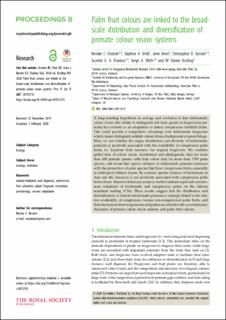| dc.contributor.author | Onstein, Renske E | |
| dc.contributor.author | Vink, Daphne N. | |
| dc.contributor.author | Veen, Jorin | |
| dc.contributor.author | Barratt, Christopher D. | |
| dc.contributor.author | Flantua, Suzette | |
| dc.contributor.author | Wich, Serge A. | |
| dc.contributor.author | Kissling, W. Daniel | |
| dc.date.accessioned | 2021-01-05T14:06:47Z | |
| dc.date.available | 2021-01-05T14:06:47Z | |
| dc.date.created | 2020-03-04T14:40:32Z | |
| dc.date.issued | 2020 | |
| dc.Published | Proceedings of the Royal Society of London. Biological Sciences. 2020, 287 (1921), 20192731 | en_US |
| dc.identifier.issn | 0962-8452 | |
| dc.identifier.uri | https://hdl.handle.net/11250/2721551 | |
| dc.description.abstract | A long-standing hypothesis in ecology and evolution is that trichromatic colour vision (the ability to distinguish red from green) in frugivorous primates has evolved as an adaptation to detect conspicuous (reddish) fruits. This could provide a competitive advantage over dichromatic frugivores which cannot distinguish reddish colours from a background of green foliage. Here, we test whether the origin, distribution and diversity of trichromatic primates is positively associated with the availability of conspicuous palm fruits, i.e. keystone fruit resources for tropical frugivores. We combine global data of colour vision, distribution and phylogenetic data for more than 400 primate species with fruit colour data for more than 1700 palm species, and reveal that species richness of trichromatic primates increases with the proportion of palm species that have conspicuous fruits, especially in subtropical African forests. By contrast, species richness of trichromats in Asia and the Americas is not positively associated with conspicuous palm fruit colours. Macroevolutionary analyses further indicate rapid and synchronous radiations of trichromats and conspicuous palms on the African mainland starting 10 Ma. These results suggest that the distribution and diversification of African trichromatic primates is strongly linked to the relative availability of conspicuous (versus non-conspicuous) palm fruits, and that interactions between primates and palms are related to the coevolutionary dynamics of primate colour vision systems and palm fruit colours. | en_US |
| dc.language.iso | eng | en_US |
| dc.publisher | Royal Society Publishing | en_US |
| dc.rights | Navngivelse 4.0 Internasjonal | * |
| dc.rights.uri | http://creativecommons.org/licenses/by/4.0/deed.no | * |
| dc.title | Palm fruit colours are linked to the broad-scale distribution and diversification of primate colour vision systems | en_US |
| dc.type | Journal article | en_US |
| dc.type | Peer reviewed | en_US |
| dc.description.version | publishedVersion | en_US |
| dc.rights.holder | Copyright 2020 The Authors | en_US |
| dc.source.articlenumber | 20192731 | en_US |
| cristin.ispublished | true | |
| cristin.fulltext | postprint | |
| cristin.qualitycode | 2 | |
| dc.identifier.doi | 10.1098/rspb.2019.2731 | |
| dc.identifier.cristin | 1799611 | |
| dc.source.journal | Proceedings of the Royal Society of London. Biological Sciences | en_US |
| dc.source.40 | 287 | en_US |
| dc.source.14 | 1921 | en_US |

